
How to Choose the Right Diamond for Engagement Rings?
Popping the question is a special moment, but the pressure to find the "right" ring can be immense. This guide will equip you with the knowledge to confidently select a diamond that shines as bright as your love while staying true to your financial goals.
What is a diamond?

A diamond is a beautiful gemstone created deep under the Earth's mantle under extreme pressure and heat. It is admired for its brilliance, longevity, and rarity. Diamonds are usually transparent and crystalline in structure, reflecting light in a mesmerizing way. These characteristics make diamonds particularly desirable for jewelry, and when used in engagement rings, they represent enduring love and devotion.
Types of Diamonds?
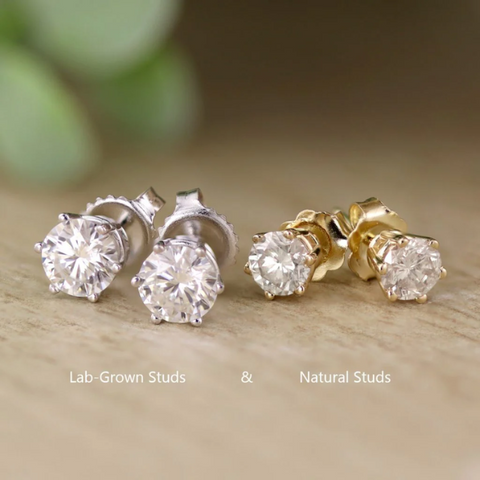
Natural diamonds are formed deep under the Earth's mantle under high pressure and heat over millions of years, giving them exceptional beauty and uniqueness.
Lab grown diamonds, on the other hand, are created in controlled surroundings with advanced technological methods that mimic the natural conditions under which diamonds originate. These diamonds have the same physical, chemical, and optical qualities as real diamonds, providing an ethical and environmentally friendly alternative to mined diamonds.
Importance of choosing the right diamond for an engagement ring?

Choosing the right diamond for an engagement ring is important for a variety of reasons. For starters, it represents the depth of a person's devotion and affection for their spouse. A carefully picked diamond demonstrates consideration and care, increasing the sentimental value of the ring. Second, the diamond's quality has a direct impact on its longevity and beauty. Choosing a high-quality diamond guarantees that the ring will remain fascinating and flawless for years to come. Choosing the ideal diamond also requires taking into account aspects such as cut, clarity, color, and carat weight, all of which add to its overall aesthetic appeal and value. As a result, devoting time and effort to choosing the ideal diamond for an engagement ring is critical to creating a meaningful and long-lasting statement of love and commitment.
Is it Better to Buy a Mounted Diamond Or a Loose Diamond?
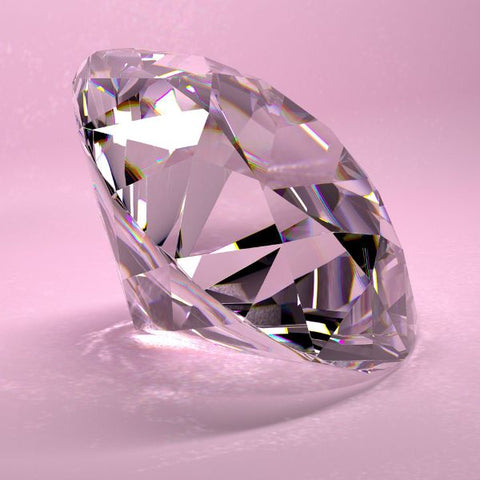
Moving forward, know which one is better Mounted or a loose diamond:
Cost: A loose diamond is typically less expensive than a mounted one. This is because when you buy a mounted diamond, you are paying for both the diamond and the setting in which it is placed. If you're on a budget, a loose diamond may be a better option.
Customization: If you have a specific design in mind for your jewelry piece, purchasing a loose diamond allows you to select the ideal diamond and then have it put in the exact setting you want. This enables further customization and personalization.
Quality Inspection: When you purchase a loose diamond, you can check it more closely for defects or imperfections. This ensures that you receive a diamond of good grade. When you purchase a mounted diamond, however, it may be more difficult to study the diamond closely because it has already been set in the jewelry.
Convenience: Purchasing a mounted diamond can be more convenient if you want a ready-made piece of jewelry. It saves you from having to find a separate setting and have the diamond put. However, this ease comes at the expense of possibly fewer selections and greater pricing.
Finally, whether you should buy a mounted diamond or a loose diamond is determined by your priorities. If you value cost-effectiveness, customization, and quality inspection, a loose diamond may be the best option. But, if convenience and having a ready-made piece of jewelry are more essential to you, purchasing a mounted diamond may be a better option. Finally, think about your tastes and needs before making a decision.
What are some popular diamond cuts for engagement rings?
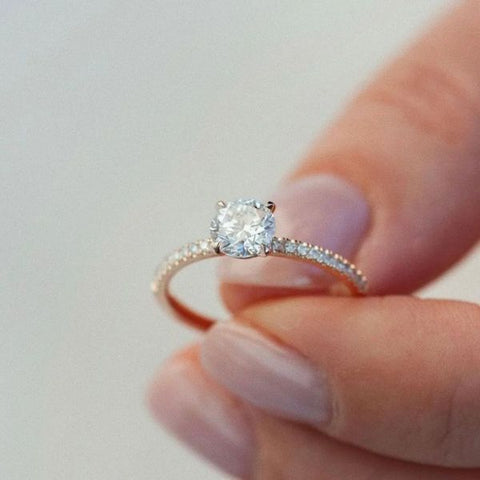
Here are some of the best diamond shapes for an engagement ring
- Round Cut Diamond
- Oval Cut Diamond
- Pear Diamond
- Marquise Diamond
- Princess Cut Diamond
- Emerald Diamond
- Cushion Cut Diamond
- Radiant Diamond
- Heart Diamond
The Round Diamond:
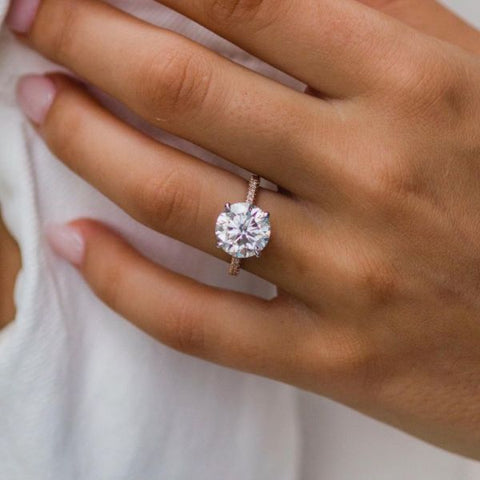
Cost: Most expensive per carat weight
Pros:
- Unmatched brilliance: The round cut diamonds are the undisputed king of sparkle, boasting a meticulous faceting pattern that maximizes light return, resulting in a breathtaking display of fire and scintillation.
- Timeless elegance: Round diamonds have transcended trends, remaining a symbol of classic beauty for centuries. Their versatility complements any setting and personal style.
Cons:
- Highest price tag: Due to the high level of skill and material waste involved in cutting a round diamond, it commands the highest price per carat compared to other shapes.
- Less surface area: While incredibly sparkly, round diamonds may appear smaller for their carat weight compared to certain elongated shapes.
Ring Settings: Prong setting (solitaire or halo), bezel setting
Flattering Fingers: Round diamonds are universally flattering, especially for shorter fingers as they create the illusion of length.
The Elongated Beauties: Oval, Pear, and Marquise
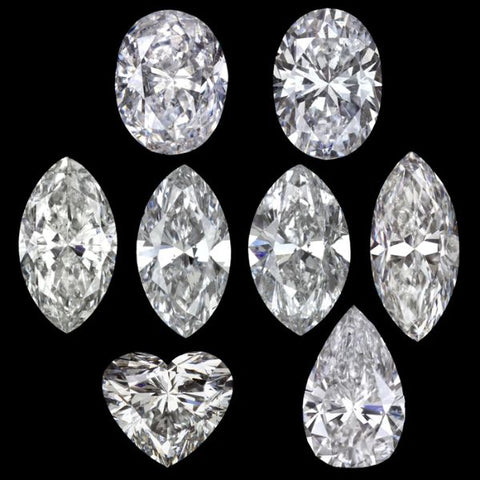
These shapes offer a captivating alternative to the round cut, creating the illusion of longer fingers.
Oval-Cut:
Cost: Generally 10-30% less expensive than round diamonds
Pros:
- Elongated grace: The oval cut diamond combines the brilliance of a round diamond with a flattering elongated shape that flatters fingers.
- Larger perceived size: For the same carat weight, oval diamonds appear bigger than round diamonds, offering more sparkle for your buck.
Cons:
- Bowtie effect: Some oval diamonds may exhibit a dark area in the center called the "bowtie." A well-cut oval minimizes this effect.
- Durability considerations: The pointed ends of the oval require a protective setting like a bezel.
Ring Settings: Solitaire setting (especially East-West setting), halo setting
Flattering Fingers: Ideal for short fingers or fingers that appear stubby, creating a lengthening effect.
Pear Cut:
Cost: This can vary depending on cut quality. Generally 15-20% less expensive than round diamonds of similar size.
Pros:
- Teardrop allure: The pear cut exudes a touch of vintage glamour with its teardrop shape and pointed end.
- Flattering silhouette: Similar to the oval, the pear cut creates the illusion of longer fingers.
Cons:
- Potential chipping: The pointed end requires a protective setting and careful handling.
- Asymmetry to consider: The pear shape diamond can appear unbalanced if not cut well. Look for a pear with a symmetrical bow and overall form.
Ring Settings: Bezel setting, basket setting
Flattering Fingers: Ideal for short fingers or wider fingers, as the pointed end draws the eye away from width.
Marquise-Cut:
Cost: This can vary depending on cut quality. Generally 20-40% less expensive than round diamonds of similar size.
Pros:
- Dramatic elegance: The marquise cut diamond, resembling a stretched oval with pointed ends, offers a touch of old-world Hollywood glamour.
- Excellent light return: A well-cut marquise can rival the brilliance of a round diamond.
Cons:
- Durability concerns: Similar to the pear, the pointed ends require a protective setting and careful handling.
- Picky setting styles: The marquise cut can be tricky to pair with certain ring settings.
Ring Settings: Bezel setting, basket setting
Flattering Fingers: Ideal for short fingers or wider fingers, as the elongated shape creates a lengthening effect.
The Geometric Wonders: Princess, & Emerald,
These geometric shapes offer a modern and sophisticated alternative to round diamonds.
Princess Cut:
Cost: Generally 10-20% less expensive than round diamonds of similar size.
Pros:
- Modern brilliance: The princess cut diamond boasts a geometric square or rectangular shape with sharp corners, offering a contemporary and vibrant sparkle.
- Durable choice: The princess cut's lack of pointed ends makes it a good choice for active lifestyles.
Cons:
- Can appear "cold": The princess cut's sharp corners may lack the warmth of a round diamond for some tastes.
- Potential chipping: While generally durable, the corners can chip if not set securely.
Ring Settings: Channel setting, prong setting (preferably four prongs for extra security)
Flattering Fingers: Ideal for longer fingers, as the square shape can balance
Cushion Cut Diamond
The cushion cut diamond evokes a sense of vintage romance with its squarish shape and softly rounded corners, resembling a plump pillow. This classic cut boasts a larger table (the flat top) that allows for a unique play of light.
Pros:
- Fire and Crushed Ice: Cushion cuts can deliver a captivating brilliance, or a softer, mystical glow known as "crushed ice" depending on the faceting.
- Value for Money: Due to the efficient use of rough diamonds, cushion cuts can be slightly more affordable than other fancy shapes for the same carat weight.
Cons:
- Sparkle Variation: The brilliance of a cushion cut can vary depending on the cut quality. A poorly cut stone might show dark areas.
- Show Imperfections: The larger table can make clarity imperfections more noticeable.
Cost: Cushion cut diamonds generally range from similar to slightly less expensive than round diamonds depending on clarity, color, and cut quality.
Ring Setting: Cushion cuts pair beautifully with halos, vintage-inspired milgrain settings, and three-stone rings.
Finger Suitability: Due to the rounded edges, cushion cuts can flatter most finger shapes, especially those with wider knuckles.
Radiant Cut Diamond
The radiant cut diamond strikes a balance between the brilliance of a round cut and the geometric appeal of an emerald cut. It has a rectangular shape with cropped corners, creating a dazzling play of light.
Pros:
- Exceptional Brilliance: With its numerous facets, the radiant cut is known for exceptional fire and sparkle, rivaling round diamonds.
- Sleek and Modern: The geometric shape exudes a contemporary feel, perfect for those who prefer a bolder look.
Cons:
- Lower Clarity Tolerance: Similar to cushion cuts, the large table might reveal clarity flaws more easily.
- Price Point: Radiant cuts can sometimes be slightly more expensive than cushion cuts due to higher diamond yield waste during cutting.
Cost: Radiant cut diamonds can range from similar to slightly more expensive than round diamonds depending on cut, clarity, and color.
Ring Setting: Radiant cuts look stunning in bezel settings, channel settings, and modern designs with clean lines.
Finger Suitability: The elongated shape of radiant cuts can elongate shorter fingers and flatter wider ones.
Heart-shaped diamonds are a romantic choice for jewelry, symbolizing love and affection. Here's a quick guide to their pros and cons:
Pros:
- Unique and eye-catching: These diamonds stand out from the classic round cut with their charming shape.
- Romantic symbol: A perfect way to express your love, especially for engagement rings or anniversary gifts.
Cons:
- Less sparkle: Heart cuts can sometimes reflect less light than round diamonds, appearing less brilliant.
- Resale value: Since they are not as popular as round diamonds, resale might be trickier.
Price range: Heart-shaped diamonds can range from $1,500 to $15,000 or more, depending on the size, cut quality, and clarity.
Setting: To protect the pointed corners, basket settings or bezel settings are ideal for heart-shaped diamonds.
Ideal fingers: Slender fingers benefit most from the elongated form of a heart diamond, creating an illusion of longer fingers.
Setting the Budget:
Now, that you know how many diamond shapes are available, here’s another thing to keep in mind:
-
Establishing the engagement ring budget demands thoughtful consideration of personal finances and long-term financial goals. Begin by assessing your financial situation and determining a reasonable amount that aligns with your comfort level and financial capacity.
Communicating the Budget: - Honesty is Key: Initiate an open and honest conversation with your partner about the budget early on. Share your financial boundaries and listen to their perspectives.
- Mutual Understanding: Foster a mutual understanding of the significance of financial planning for the engagement ring. Discuss the importance of financial responsibility and the implications of overspending.
- Collaborative Decision-making: Approach the budget discussion as a collaborative effort, emphasizing the joint commitment to building a future together. Explore compromises and find a balance that satisfies both partners' preferences and financial realities.
Myth: "Saving 5 months' salary is the golden rule for buying an engagement ring."
- Explanation: While it's a widely circulated notion, it's not a steadfast rule. The idea originated as a marketing strategy rather than a practical guideline. It's more important to consider your financial situation and find a ring that holds sentimental value rather than strictly adhering to this myth.
Myth: "A bigger price tag equals a more stunning ring."
- Explanation: The value of an engagement ring doesn't solely depend on its cost. It's about finding a ring that reflects your partner's style and preferences. Focus on the quality, craftsmanship, and meaning behind the ring rather than just its price.
Myth: "You must go into debt to afford a stunning engagement ring."
- Explanation: It's unwise to start your journey into marriage burdened with debt from purchasing a ring. Financial stability and transparency are crucial in a relationship. You can find beautiful rings within your budget by exploring different options like lab-grown diamonds, alternative gemstones, or vintage rings.
Myth: "The more you spend, the more you love your partner."
- Explanation: Love is not measured by the price tag of a ring. The true value lies in the commitment and bond shared between partners. Don't feel pressured to overspend on a ring to prove your love. Instead, focus on creating meaningful moments and building a strong foundation for your future together.
Myth: "The engagement ring should be a surprise, regardless of the cost."
- Explanation: While surprises can be romantic, communication is key when it comes to such an important purchase. It's essential to discuss preferences, styles, and budgets openly with your partner to ensure you select a ring that they'll cherish. This way, you can still maintain an element of surprise while also ensuring the ring aligns with their desires and financial comfort.
The 4C’s of diamond
- The 4C's of a diamond refers to four key factors that are used to evaluate the quality and value of a diamond: cut, color, clarity, and carat weight.
- Cut: The cut of a diamond refers to its proportions, symmetry, and polish. A well-cut diamond reflects light internally and disperses it through the top, giving it sparkle and brilliance.
- Color: Diamond color is graded on a scale from D (colorless) to Z (light yellow or brown). The less color a diamond has, the more valuable it is considered to be. Colorless diamonds allow more light to pass through, enhancing their sparkle.
- Clarity: Clarity measures the presence of internal and external flaws, or inclusions, within a diamond. Diamonds with fewer inclusions are more valuable because they allow more light to pass through, increasing their brilliance and sparkle.
- Carat Weight: Carat weight refers to the weight of a diamond, with one carat equaling 0.2 grams. Generally, larger diamonds are more rare and valuable, but other factors such as cut, color, and clarity also influence a diamond's worth.
Which of the 4 C's is the Most Important?
Among the 4C's of diamond, the most important factor is often considered to be the cut. This is because the cut of a diamond directly influences its sparkle, brilliance, and overall appearance. A well-cut diamond reflects light effectively, maximizing its fire and brilliance. Even if a diamond has excellent color, clarity, and carat weight, a poor cut can diminish its beauty and value. Conversely, a diamond with a superior cut can enhance the appearance of its color and clarity, making it more visually appealing. Therefore, while all four factors are important in evaluating a diamond, the cut is often regarded as the most crucial aspect in determining its overall beauty and value.
What is the ideal carat size for a diamond engagement ring?
There isn't one ideal carat size for every Diamond engagement ring! It relies on a few factors:
Budget: As diamonds grow in size, their price increases. The average engagement ring in the United States weighs approximately 1 carat, although it might be smaller or greater depending on your budget.
Finger size: A smaller diamond (0.7 to 1 carat) will appear larger on a petite finger (6.5 or less), but a larger stone (1.5 to 2 carats) will balance out a larger finger.
Lifestyle: Larger diamonds tend to snag on things more easily. If your companion is active or works with their hands, a smaller stone may be more suitable.
Personal Preference: Talk with your partner! Do they love a large, sparkling rock or something more understated?
Here's a quick guide:
- Smaller fingers (size 6.5 and below): 0.7 to 1 carat
- Average fingers (size 6.5 to 8): 1 to 1.5 carat
- Larger fingers (size 8 and above): 1.5 to 2 carat (or even bigger!)
Remember, the most important thing is to pick a ring your partner will love and wear every day. Consider their personality and style over carat size!
What is a good carat weight for an engagement ring?
Personal tastes, budget, and ring style all play a role in determining the appropriate carat weight for an engagement ring. Carat weight is the size of the diamond or gemstone in the ring. The bigger the carat weight, the larger and more visible the stone will be.
For many people, the "ideal" carat weight for an engagement ring ranges between 0.5 and 1.5 carats. This category often finds a balance between size and price. It is crucial to consider the recipient's style choices as well as the diamond or gemstone's quality.
If the budget allows, some may choose a greater carat weight, such as 2 carats or more, to make a bold statement with their ring. However, larger stones are frequently more expensive.
Smaller carat weights, such as those less than 0.5 carats, can still be gorgeous engagement ring options, especially when combined with exquisite settings or accent stones.
What is the difference between a carat and a cut?
Carat and cut are two important factors to consider when buying a diamond ring.
Carat: Carat refers to the weight of the diamond. It's like measuring how heavy the diamond is. The more carats, the heavier the diamond. However, it's essential to note that carat doesn't directly indicate the size of the diamond. Sometimes, a diamond with fewer carats might appear larger if it's cut in a certain way.
Cut: Cut, on the other hand, refers to how well the diamond is shaped and polished. It's about the diamond's angles, proportions, and symmetry. A well-cut diamond reflects light beautifully, making it sparkle more. Cut is crucial because it determines how brilliant and beautiful the diamond looks.
Carat refers to the weight of the diamond, while cut refers to the proportions and facets that influence sparkle.
Carat measures the physical weight of the diamond, where one carat equals 200 milligrams. It's essential to note that the carat alone doesn't determine a diamond's value or beauty.
Now, let's talk about how these factors affect the budget of the ring and their importance:
- Budget: Generally, the larger the carat weight, the more expensive the diamond. So, if you're looking for a bigger diamond, you'll need to be prepared to spend more money. However, the cut can also impact the price. A well-cut diamond might be more expensive because it requires skilled craftsmanship to achieve that perfect sparkle.
- Importance: Both carat and cut are important for different reasons. Carat is often associated with the size of the diamond, which can be significant for some people who want a noticeable and impressive ring. However, cut is equally important because it determines how the diamond actually looks. A well-cut diamond can make even a smaller-carat diamond look stunning. Plus, a beautifully cut diamond will continue to sparkle and shine for years to come, making it a timeless and valuable piece.
FAQ’S
Do you pick out engagement rings together?
Choosing an engagement ring together can be a wonderful bonding experience. It allows both partners to express their preferences and ensures that the ring reflects the style and personality of the wearer. It also eliminates the risk of selecting a ring that may not align with the recipient's taste.
On the other hand, selecting the ring as a surprise can add an element of excitement and romance to the proposal. It's a gesture that shows thoughtfulness and consideration on the part of the person making the choice. However, it's important to have a good understanding of your partner's style and preferences if you choose to go this route.
Ultimately, the decision of whether to pick out engagement rings together or not depends on the couple's preferences and relationship dynamics.
Can I see inclusions in a diamond with the naked eye?
Whether inclusions are visible to the naked eye depends on the clarity grade of the diamond. Clarity grades range from FL (Flawless) to I3 (Included). Diamonds with higher clarity grades (e.g., FL, IF, VVS) typically have no visible inclusions without magnification.
However, diamonds with lower clarity grades (e.g., SI2, I1, I2, I3) may have inclusions visible to the naked eye. For example, an SI2 diamond may have inclusions that are visible without magnification, affecting its appearance.
Is a D color diamond always the best?
- While D color diamonds are colorless, not all D color diamonds are necessarily the best choice.
- D color is the highest grade on the GIA color scale, indicating a completely colorless diamond. However, other factors like cut, clarity, and carat weight also influence a diamond's overall appearance and value.
- Some diamond cuts, such as emerald cuts, may reveal slight yellowish tones more prominently, even in higher color grades. Thus, the "best" diamond depends on various factors, including personal preference and budget.
Should I get a diamond grading report?
It's highly recommended to obtain a diamond grading report, such as from GIA (Gemological Institute of America). A grading report provides detailed information about the diamond's 4Cs (cut, color, clarity, and carat weight), ensuring transparency and quality assurance. With a grading report, you can make informed decisions about your diamond purchase, knowing its characteristics and value accurately.
What is a halo setting and does it make the diamond look bigger?
A halo setting features smaller diamonds surrounding the center stone, creating a halo effect and enhancing the overall brilliance and sparkle.
The halo setting can make the center diamond appear larger than it actually is, adding perceived value and visual impact to the engagement ring.
Can I negotiate the price of an engagement ring?
Some jewelers offer flexibility in pricing, especially for loose diamonds and settings.
It's acceptable to negotiate the price of an engagement ring, particularly if you're purchasing from a reputable jeweler or during special sales events.
What if my fiancé(e) doesn't like the ring?
- If your fiance(e) doesn't like the engagement ring, most jewelers have return or exchange policies in place.
- Communicate openly with your partner about their preferences to ensure satisfaction with the ring choice.
Can you return an engagement ring to the store?
Yes, you can typically return an engagement ring to the store, but it depends on the store's return policy. Many jewelry stores offer a return or exchange period during which you can bring back the ring if it doesn't meet your expectations or if there's an issue with it. However, it's essential to check the store's return policy before making a purchase to understand any conditions or restrictions that may apply. Review the store's policy and contact them for assistance.
How can I clean and care for my engagement ring?
Regular cleaning with gentle soap and water can help maintain the brilliance of your engagement ring.
Professional cleaning by a jeweler every few years ensures thorough maintenance and inspection for any potential issues.
Avoid exposing the ring to harsh chemicals or abrasive materials, and consider periodic inspections to ensure the settings are secure.
What is diamond insurance?
Diamond insurance provides coverage for your engagement ring in the event of loss, theft, damage, or other unforeseen circumstances. Diamond insurance specifically tailored for engagement rings provides comprehensive coverage, including repairs, replacements, and even coverage for resizing or upgrading your ring. Investing in a diamond insurance policy offers peace of mind knowing that your cherished symbol of love is adequately protected against any potential risks or accidents.
What if I'm still unsure?
If you're still unsure about any aspect of choosing an engagement ring, don't hesitate to seek guidance from a reputable jeweler. Experienced jewelers can offer valuable insights, educate you on diamond quality and characteristics, and help you navigate the multitude of options available. Whether you have questions about diamond grading, setting styles, or budget considerations, a knowledgeable jeweler can provide personalized assistance to ensure that you find the perfect ring for your loved one. Take advantage of their expertise and resources to make an informed decision that reflects your unique relationship and preferences.








